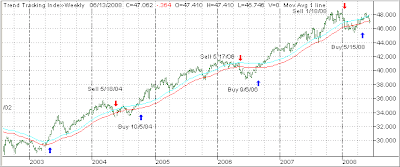I get a lot of e-mails and comments about my articles and weekly updates. I find most of them constructive, but once in a while I get a real winner. This was the case yesterday, when reader Doug had this to say:
I was disappointed in your facetious comment in the second paragraph under MIXED BAG, regarding the CPI numbers. I’m absolutely sure you understand the reasoning behind keeping food and energy prices out of the CPI, but can you be so sure each of your readers also does? Your attempt at humor in that paragraph is misleading and ill-advised.
Lest this email appear completely negative, let the record show that I thoroughly enjoy your weekly newsletter.
Hmm, here we are at the brink of a recession, with the financial system in shambles, gas, energy and food prices at an all time high and showing no signs or receding, and this reader is worried about my facetious comment.
The direction this economy is going, I will be making a lot more facetious comments in the future just to underscore the silliness of some the skewed numbers being released or things like Fed chief Bernanke’s comments that the danger of downturn has faded among many others.
I am not an economist, but I read a lot about economic events, since they all tend to affect the investment arena. I suggest that this reader focuses his energies on the reality of things as pointed out succinctly in the latest issue of Dr. Housing Bubble called “Cultural Spending Neurosis,” and maybe then he will understand that a sense of humor is badly needed to survive in this environment:
I was having a conversation with someone last week regarding his home equity line being shut down. He was rather distraught and frustrated by the sudden move of the lender to close off his line due to market conditions here in California. “How can they do that? They have no right to take away my hard earned money!”
Aside from restraining myself from smacking him upside his head I did ask him how he earned that money that was now gone. “My home equity was my money. The bank has no right in closing access to my money.” Welcome to the new mentality of wealth in our nation.
This simple conversation is the tip of the iceberg of the challenge that is now confronting our nation. In the past few decades, Americans have arrived to the current distorted point in reality where alternate universes collide and somehow debt is now the equivalent to wealth. I should actually clarify that last statement in light of the above conversation about home equity lines being shut down:
“Wealth in the last decade isn’t how much you save or your net worth. Wealth is determined by your ability to have access to large amounts of easy debt via credit lines and maximum leverage.”
That is a very important point and once you grasp this knowledge, you can understand why we are in the predicament we are in. Today, retail sales numbers perked up and the market initially came out of the gate with guns-a-blazing. That is until folks stopped for two seconds and did the current economic math:
A: If all recent data is showing us that consumers are tapped out.
B: Home prices are still declining and foreclosures are rising.
C: Consumer inflation is hitting on every front.
D: Then how can Americans still be spending?
Let me show you how:
“American credit card debt is growing at the fastest rate in years, a fact that may signal coming trouble for the banks that issue them.
The Federal Reserve reported this week that the amount outstanding of revolving consumer credit hit $937.5 billion in November, on a seasonally adjusted basis, up 7.4 percent from a year earlier.
The annual growth rate has now been above 7 percent for three months running, the first such stretch since 2001, when a recession was driving up borrowing by hard-pressed consumers.
The surge in credit card borrowing comes as credit card default rates are gradually rising, albeit from low levels, and may reflect the fact that it has gotten harder for consumers to borrow against the value of their homes, both because home values have fallen in many markets and because mortgage lending standards have tightened.”
Now the above article was posted in January but now we are close to $1 trillion in revolving consumer debt out there. And the more ominous problem is that defaults are rising in this area. So what has occurred in the above equation is due to the lack of wage growth, people were using leverage via mortgages and consumer debt to bridge the Joneses gap.
…
It is rather shocking that American households have approximately $13.84 trillion in debt obligations. In 1993, this number was at $4.2 trillion so we’ve nearly triple our national household debt in the matter of 15 years. That $13.84 trillion is a very large number and to put that into context, the estimate GDP for the entire United States for 2007 was $13.84 trillion.
…
We spend every last penny! Is it any wonder why Americans have a negative personal savings rate? You really have to wonder how people can spend more than they earn but that is essentially the way we as a nation have been living for the past decade. This housing bubble fueled by the debt bubble was only a logical extension of the cultural financial neurosis.
The great majority of the public started associating the ability to access credit with true financial prosperity. Well as we all now know, anyone with a pulse and one tooth was able to get a large mortgage in California by simply making things up.
Need we remind you about the farmer making $14,000 a year with access to a $720,000 loan? Or what about the hundreds of credit card offers Americans receive each year in the mail? When debt is no longer seen as a necessary evil and a sign of wealth, new definitions take hold of mass psychology.
…
That is why at the height of pseudo prosperity and the pinnacle of the housing bubble, Americans had for the first time crossed the negative savings barrier. This is the perfect example of watering down the definition of wealth in our country; collectively as a society people started having an aversion to saving money and a liking to debt.
This of course is a major problem and no country can survive in the long run with crushing amounts of debt. I don’t care what kind of math political parties want to sell you but there is no way a country can be prosperous in the long run by running larger and larger deficits.
This implosion of the credit (debt) markets is simply a decade long debt ponzi scheme that can go on no longer. Consumer psychology still can’t understand why fuel is rising or why everything from education to groceries are costing much more. The perfect scheme was to con people into believing that going into debt, meaning you were spending tomorrow’s dollars today, was somehow a prudent way toward wealth.
And the entire idea of savings lost its allure. In fact, society punished savers implicitly. For much of the past, if you bought a home folks knew that you had the diligence and restraint to hunker down for 2 or 3 years and put off conspicuous consumption for a larger goal such as a home. That entire romanticism of saving went out the window when anyone and everyone was getting BMWs and McMansions with zero down.
In fact, if you were renting and saving and trying to be frugal, you were seen as an outcast and a bum because you just missed out in a home that just went up $50,000 in one years simply because everyone was smoking the housing peyote. I wonder how many people had a kitchen conversation like this circa 2003:
Spouse A: “We should buy a home. The Perma Bulls down the street bought a home last year and they now have $50,000 in equity.”
Spouse B: “But it doesn’t make sense. How can a home be worth $50,000 more if they didn’t do anything?”
Spouse A: “Well here we are saving and all we’ve been able to save in our 2% savings account is $15,000. What if homes go up $50,000 again next year?”
Spouse B: “That can’t be because that makes no economic sense. Prices go up and correspond to some fundamental reason.”
Spouse A: “I heard that they got a home equity line and took a trip to Europe. Isn’t that great and fantastic? We actually make a bit more than they do but why do we live and feel poorer?”
Spouse B: “I don’t know. It just doesn’t make sense. I feel uncomfortable going into that large of debt. Why is that?”
Spouse A: “Because you’re stupid?”
Spouse B: “No. You are stupid you moron and don’t understand the difference between net worth and being in debt.”
Spouse A: “Isn’t wealth about what you can buy? We don’t take fancy trips or even have our own home! You are the true idiot you financial midget with no home.”
Spouse B: “I hate you.”
Spouse A: “I’m leaving you.”
Spouse B: “Go ahead and take the dog while you’re at it. I always hated how he looked at me anyways.”

What a lovely and heart warming story don’t you think? As you can see from the above sign, many people did have a conversation like this except in our story above, the couple split ways because of diverging financial goals and with that lawn sign, we can see that some folks unfortunately realized that selling a home in a busted bubble is no easy task.
This is the real deal here folks. We are shifting back whether we want to or not. The real psychological shift that is unfolding is the ability to break down wants and needs. A big gas guzzling car is a want and many folks are painfully realizing this. A large crushing mortgage for a McMansion is a want. Food and education are needs. Time to get these equations recalibrated before the market recalibrates them for you.
You can’t be any more direct than this. To me, this viewpoint is right on and is simply a realistic assessment as how things are and not what we would like them to be.
 Reader Steve is still unclear about an important part of Trend Tracking, namely when to take profits. He writes as follows:
Reader Steve is still unclear about an important part of Trend Tracking, namely when to take profits. He writes as follows:





